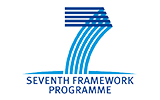
During the entire e-Highway2050 project, significant interim and final results of individual work packages, including stakeholder workshops and consultations, will be published under the ‘Results’ section from 2013 to the end of 2015. This section is continuously extended. One overall result is the Modular Development Plan which will present the architectural possibilities of the electricity transmission network in 2050, including, among other information, the assumptions and calculations for electricity generation, demand and transmission technologies until 2050. Moreover, a network planning method will be developed to serve as the basis for all future long-term network planning. After project completion, the ‘body of knowledge’ will present all project results in a target group-specific and interactive format.
e-Highway2050 articles available on the GridInnovation-on-line Knowledge Sharing Platform
GridInnovation-on-lineKnowledge Sharing Platform
Results
All resulting documents can be used for further studies, planning and research purposes. You can search according to year, work package and type of result in order to obtain the desired document. For example, workshop and consultation results, as well as interim results of specific work packages, are all available.
 Deliverables
Deliverables Consultations
Consultations Stakeholder Workshops
Stakeholder Workshops
-

D3.2 Technology innovation needs
-

D8.6.a_Detailed enhanced methodology for long-term grid planning
-

D8.6.b_Enhanced methodology for long-term grid planning prototype
-

D8.7_Recommendations about critical aspects in long-term planning methodologies
-

D2.4_Contingency Analyses for Candidate grid architectures for 2050
-

D4.3 Data sets of scenarios and intermediate grid architectures for 2040
-

D5_1_Towards a governance model for the European electricity transmission network in 2050
-

D6.3_Modular plan over 2030-2050 for the European transmission system a complete analysis of costs and benefits
-

D4.2b Testing Aspects of the SESA Methodology to Grid Architectures of Large Scale RES and 100 RES
-

D4.1 Operational validation of the grid reinforcements by 2050
-

D4.4 Modular development plan from 2020 to 2050
-

e-Highway database per country
-

D3.1 Technology assessment from 2030 to 2050
-

Impacts of ICT on the pan-European Power System up to the 2050 Time Horizon
-

Note on power to gas
-

Report AC OHL
-

Report Batteries
-

Report Cables
-

Report CAES
-

Report CHP
-

Report demand technologies selection a
-

Report demand technologies selection b
-

Report electric vehicles
-

Report FACTS
-

Report Generation
-

Report Heat Pumps
-

Report HVDC
-

Report LED and lighting
-

Report OHL HVDC
-

Report protection and control
-

Report transformers AC breakers
-

Report wind power
-

Related Articles - Boundary conditions
The e-Highway 2050 project: Modular Development Plan of the Pan-European Transmission System 2050
-

Related Articles - 2050 Scenarios Grid Architecture
e-Highway 2050: Approach towards a European cluster model
e-Highway 2050 : Methodology for 2050 scenario quantification
e-Highway 2050: Grid reinforcements design for long term transmission planning in Europe
e-Highway 2050: Grid architectures for 2050
-

Related Articles - Technologies
e-Highway 2050: Performance and cost database of a portfolio of power system technologies expected to impact grid architecture studies at 2050
e-Highway 2050: A methodology to define power technologies expected to impact grid architecture studies at 2050
e-Highway 2050: Management of uncertainties and data contextualization in the framework of the technology assessment of power system technologies expected to impact grid architecture studies at 2050
e-Highway 2050: a methodology for building future costs of transmission technologies in the framework of the technology assessment of power system technologies expected to impact grid architecture studies at 2050 -

Related Articles - Governance
e-Highway 2050: Regulatory options for the European electricity transmission network in 2050
-

Related Articles - Socio Economic Profitability
e-Highway 2050: A new multi-criteria cost-benefit methodology to compare new transmission investments
Costs benefit analysis of the selected 2050 pan- European grid architectures for each of the five scenarios
-

Related Articles - Enhanced Planning Methodology
e-Highway 2050 : Enhanced Pan-European Transmission Planning Methodology
e-Highway 2050 : The importance of spatial correlations in Monte Carlo adequacy simulations
e-Highway 2050 : Methodology for network reduction according to critical branches: focus on network partition
e-Highway 2050 : Methodology to develop an optimal zonal grid expansion plan considering several scenarios: focus on snapshot selection
e-Highway 2050: Recommendations about potential solutions to address challenges in long-term grid planning
-

Related Articles - Operational Environmental Assessments
Methodology for strategic environmental and social assessment of grid reinforcements at 2050
-

e-Highway2050 Toolbox
-

e-Highway2050 2050 Country and cluster installed capacities
-

D8_5b: Prototype to assess robustness of a grid architecture
-

D8_5a: Enhanced methodology to assess robustness of a grid architecture
-

D8.4.b: Prototype for optimal modular plan to reach 2050 grid architectures
-

D8.4.a: Enhanced methodology to define the optimal modular plan
-

D8.3.b: Prototype for the definition of optimal grid architectures for 2050
-

D8.3.a: Enhanced methodology to define optimal grid architectures for 2050
-

D8.2.b: Demand Generation scenarios prototype
-

D8.2.a: Enhanced methodology for the computation of Demand Generation scenarios
-

D6 2: A Toolbox supporting a pan-European technical evaluation of costs and benefits
-

D2_2: European cluster model of the Pan-European transmission grid 20072015
-

D2_1: Data sets of scenarios for 2050 20072015
-

D 2.3: System simulations analysis and overlay grid development
-

D 2.3: System simulations analysis and overlay grid development digest
-

Results of Stakeholder Workshop: Enhanced pan-European Transmission Planning Methodology
On May 28th and May 29th 2015, the 6th e-Highway2050 workshop took place. The purpose of this workshop was to present and exchange on an enhanced methodology using optimization methods for long-term transmission expansion planning over large systems in the scope of the workpackage 8 of the e-Highway2050 project.
-

Results of Stakeholder Workshop: Cost Benefit Analysis Methodology for the Modular Development Plan of the Pan-European Transmission Network at 2050
On 20th March 2014, the e-Highway2050 workshop "A pan-European Cost Benefit Analysis methodology for the modular development plan of the pan-European transmission network at 2050" took place in Brussels. Project partners and European stakeholders discussed the cost-benefit methodology proposed by the project for analyzing new investments on the pan-European transmission corridors up to 2050. The workshop's active debate provided valuable input for the finalization of the approach.
-

A comprehensive long term benefit cost assessment for analyzing pan-European transmission highways deployment (by WP6)
This document is the deliverable D6.1 of the e-Highway2050 project. It has been developed by WP6 (Socio economic profitability) and contains a comprehensive long term benefit cost assessment for analyzing pan-European transmission highways deployment.
-

European cluster model of the Pan-European transmission grid (by WP2)
This document is the deliverable D2.2 of the e-Highway2050 project. It has been developed by WP2 (Developing the Grid architecture options as a function of the retained scenarios) and contains a European cluster model of the Pan-European transmission grid.
-

Methodology for environmental and sustainability assessment and results of its application to the assessment of strategic options (by WP4)
This document is the deliverable D4.2a of the e-Highway2050 project. It has been developed by WP4 (Modular development & operations) and contains a Methodology for environmental and sustainability assessment and results of its application to the assessment of strategic options.
Download Link
-

High-level definition of a new methodology for long-term grid planning (by WP 8)
This document is the deliverable D8.10 of the e-Highway2050 project. It contains the high-level description of the new methodology for long-term grid planning that will be developed by Work Package 8.
-

Structuring of uncertainties, options and boundary conditions for the implementation of EHS (by WP 1)
The main purpose of Deliverable D1.2 as final deliverable of Work Package 1 of e-Highway2050 is to summarize the main findings from the different tasks in the work package and present recommendations for the following work in e-Highway2050. This document structures uncertainties/futures, options/strategies and corresponding boundary conditions for the implementation of EHS that were identified in the different tasks of WP1, in particular technological, economical, political, socio- political and environmental uncertainties and options. The reports from the different WP1 Milestones are confidential but can be accessible upon request to the Coordinator.
-

Results of Stakeholder Workshop on Generation adequacy on the electricity supply-demand-balance in Europe for 2050 on 10th October 2013
The objective of the second e-Highway2050 stakeholder workshop was to present and exchange on the methodology built to assess the energy mix and load in 2050 at the Pan-European level for each scenario already defined by the project and to discuss the actual first results of quantification.
For further information on the content please see the presentations of the workshop. -

Executive Summary "Setting the Boundary Conditions for 2020 -2050 Grid Planning" (by WP 1)
Work package 1 (WP1) of the e-Highway2050 project establishes a comprehensive set of Boundary Conditions to inform all participants of the opportunities and limitations that are required to bring about a successful transition from today's solutions to the next generation of infrastructure needed to support an integrated power system with electricity generation driven predominantly by renewable energy sources in 2050.
-

Review of useful studies, policies and codes (by WP 1)
The objective of this document as the first of two deliverables from WP1 is to collect current knowledge and expectations about future developments in Europe, as seen from the TSO side and in other relevant scenario studies. Together with the outputs from the other tasks this report will be a supplement to the final deliverable D1.2 of WP1.
-

Results of Stakeholder Workshop on Boundary conditions and scenarios identification for the 2050 transmission system on 23rd January 2013.
The objectives were to define the limits of the study, the so-called ”boundary conditions”, and to define a robust methodology for the identification of energy scenarios. The scenarios will be used all along the project in order to foresee the possible development of the transmission network in Europe.
For further information on the content please see the workshop programme, the workshop memo and the presentations of the workshop.



